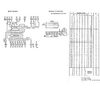I have a Uniden PC-122 that I have had since it was new, about 1993. It is unmodified. I dug it out recently and powered it up. Channel display and everything else seems to be working perfectly, but it neither receives nor transmits in any mode. Tried an external speaker; still no band noise. The PA function does work, hence the modulator works. I opened it and looked at the board, didn't see anything amiss. None of the electrolytics are swollen or anything like that.
I've reached out to Handy Andy because I've seen references to information he had on cbtricks, but don't have access to the actual files. I know there are other folks on here with in-depth info about this rig, so I figured I would put it out here as well.
Anyone have any insight as to common problems or what is the next step for troubleshooting? Any help will be much appreciated.
I've reached out to Handy Andy because I've seen references to information he had on cbtricks, but don't have access to the actual files. I know there are other folks on here with in-depth info about this rig, so I figured I would put it out here as well.
Anyone have any insight as to common problems or what is the next step for troubleshooting? Any help will be much appreciated.










